- Age-related macular degeneration (AMD) is an eye disease that can blur your central vision. It happens when aging causes damage to the macula — the part of the eye that controls sharp, straight-ahead vision. The macula is part of the retina (the light-sensitive tissue at the back of the eye).
AMD is a common condition — it’s a leading cause of vision loss for older adults. AMD doesn’t cause complete blindness, but losing your central vision can make it harder to see faces, read, drive, or do close-up work like cooking or fixing things around the house.
AMD happens very slowly in some people and faster in others. If you have early AMD, you may not notice vision loss for a long time. That’s why it’s important to get regular eye exams to find out if you have AMD.
(PLEASE CLICK HERE FOR TAMIL TEXT FORMAT: AGE RELATED MACULAR DEGENERATION)


There are two types of AMD
Dry AMD
Most people with AMD have dry AMD (also called atrophic AMD). This is when the macula gets thinner with age. Dry AMD happens in 3 stages: early, intermediate, and late. It usually progresses slowly over several years. There’s no treatment for late dry AMD, but you can find ways to make the most of your remaining vision. And if you have late dry AMD in only 1 eye, you can take steps to protect your other eye. of AMD:
Wet AMD
Wet AMD (also called advanced neovascular AMD), is a less common type of late AMD that usually causes faster vision loss. Any stage of dry AMD can turn into wet AMD — but wet AMD is always late stage. It happens when abnormal blood vessels grow in the back of the eye and damage the macula. The good news is that treatment options are available for wet AMD.
Symptoms:
Early dry AMD doesn’t cause any symptoms.
In intermediate dry AMD, some people still have no symptoms. Others may notice mild symptoms, like mild blurriness in their central vision or trouble seeing in low lighting.
In late AMD (wet or dry type), many people notice that straight lines start to look wavy or crooked. You may also notice a blurry area near the center of your vision. Over time, this blurry area may get bigger or you may see blank spots. Colors may also seem less bright than before, and you may have more trouble seeing in low lighting.

Your risk for AMD increases as you get older. People age 55 and older are more likely to have AMD. The risk for AMD is also higher for people who:
• Have a family history of AMD
• Smoke
If you’re at risk for AMD because of your age, family history, or other factors, it’s important to get regular eye exams. Ask your doctor how often you need to get eye exams. Early AMD doesn’t have any symptoms, so don’t wait for your vision to change!
How can I lower my risk for AMD?
Research shows that you may be able to lower your risk of AMD (or slow vision loss from AMD) by making these healthy choices:








How will my eye doctor check for AMD?
Eye doctors can check for AMD as part of a comprehensive dilated eye exam. The exam is simple and painless — your doctor will give you some eye drops to dilate (widen) your pupil and then check your eyes for AMD and other eye problems.
Your doctor may also recommend doing a test called optical coherence tomography (OCT). In an OCT test, your eye doctor will take pictures of the inside of your eye with a special machine.
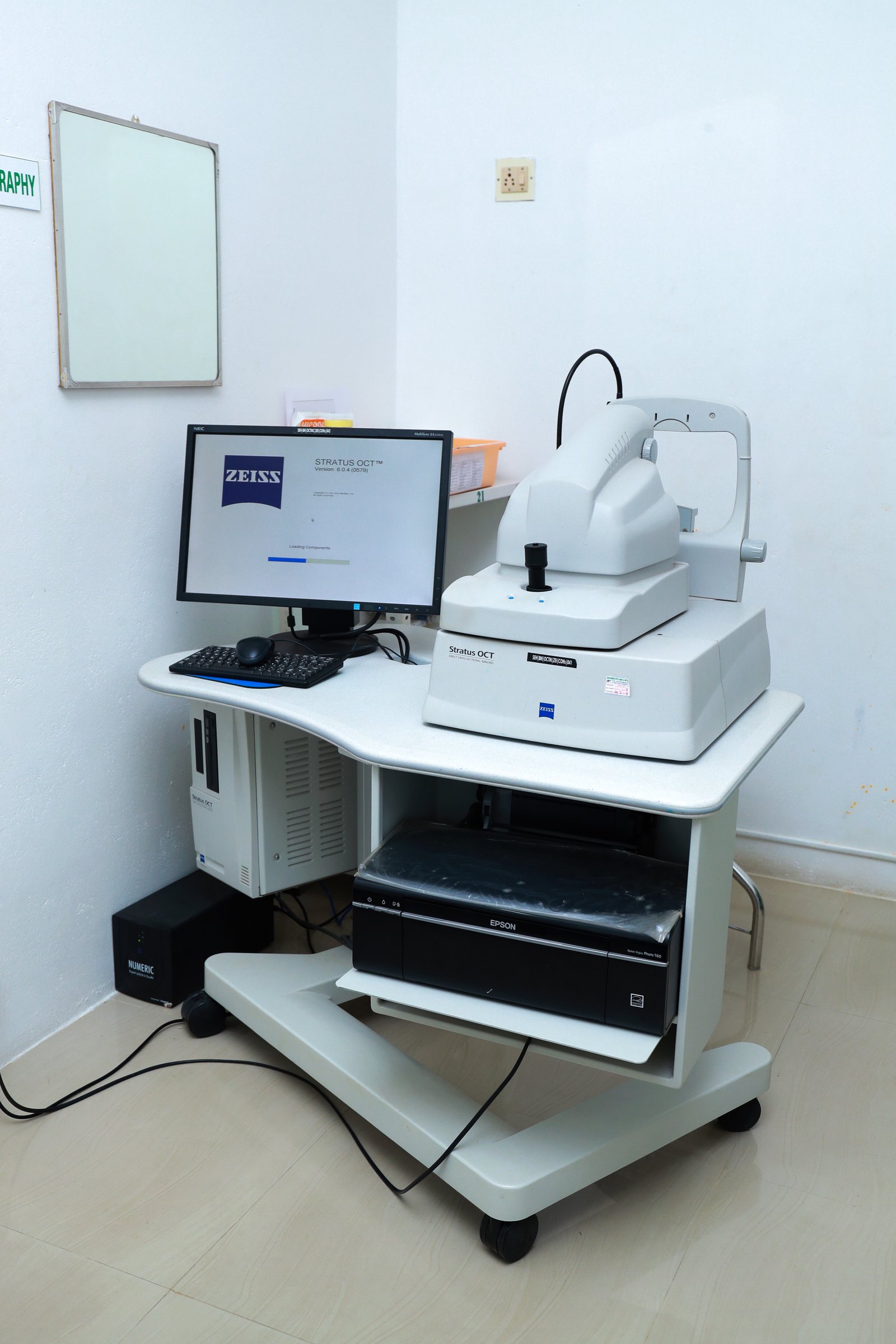
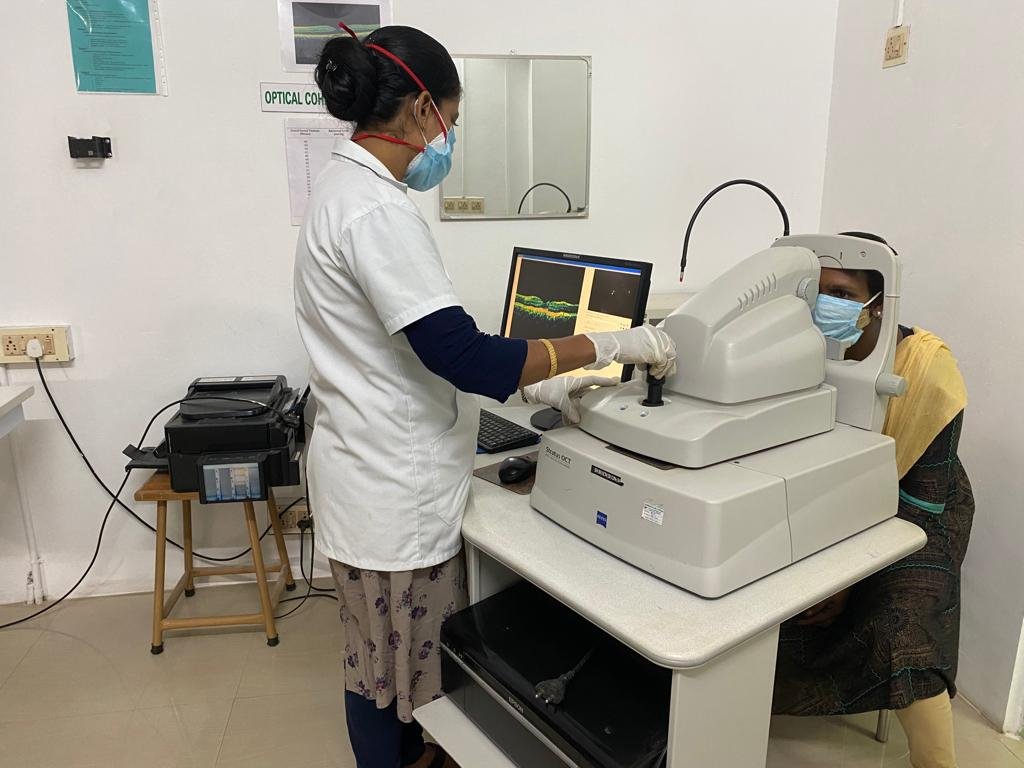
Optical Coherence tomography (OCT) PICTURES BEING TAKEN AT - Dr. SURESH EYE HOSPITAL
TREATMENT
Treatment for AMD depends on the stage and type. There’s currently no treatment for early AMD, so your eye doctor will probably just keep track of how your eyes are doing with regular eye exams. Eating healthy, getting regular exercise, and quitting smoking can also help.
If you have intermediate AMD in 1 or both eyes, special dietary supplements (vitamins and minerals) may be able to stop it from turning into late AMD. If you have late AMD in only 1 eye, these supplements may slow down AMD in your other eye.
If you have intermediate AMD in 1 or both eyes, special dietary supplements (vitamins and minerals) may be able to stop it from turning into late AMD. If you have late AMD in only 1 eye, these supplements may slow down AMD in your other eye.
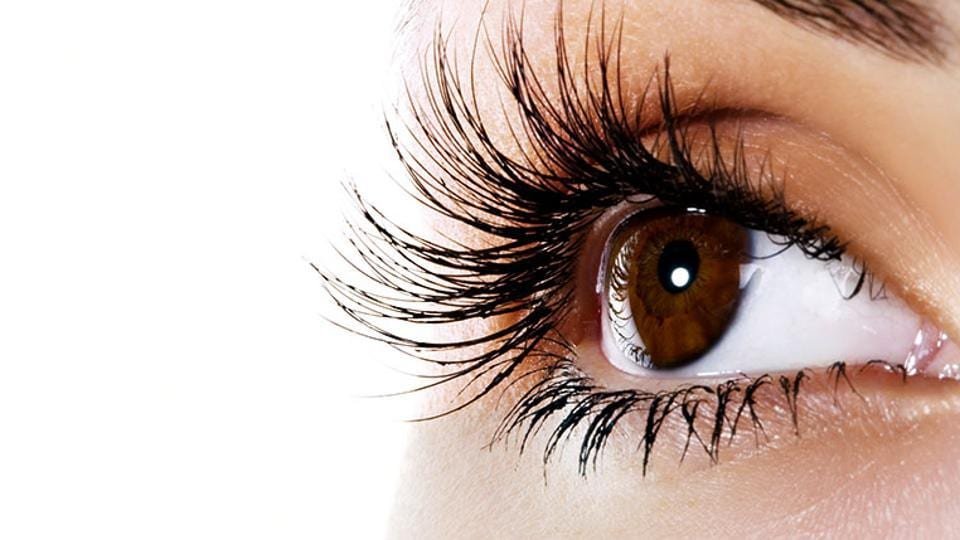
AREDS 2 Supplements for Age-Related Macular
Degeneration (AMD)
Age-related macular degeneration (AMD) is an eye disease that can blur the center of your vision. If you have intermediate AMD in 1 or both eyes, special dietary supplements called AREDS 2 can help slow down vision loss.
Are AREDS 2 supplements
right for me?
It depends what stage of AMD you have. If you have intermediate AMD in 1 or both eyes, they may be able to stop it from turning into late AMD.
AREDS 2 supplements can’t prevent early AMD from developing into intermediate AMD. If your eye doctor tells you that you have early AMD, get a dilated eye exam at least once a year so your doctor can keep track of any changes.
If you have late AMD in only 1 eye, AREDS 2 may slow down the progression of AMD in the other eye. If you already have late AMD in both eyes, AREDS 2 supplements probably won’t help. But low vision resources can help you make the most of your remaining sight.

Are there
any risks or side effects?
Because AREDS 2 supplements have very large amounts of vitamins and minerals, they may change the way your body digests food. They can also change the way that other medicines work in your body.
An older type of these supplements — called “AREDS” instead of “AREDS 2” — have beta-carotene, which can increase the risk of lung cancer in people who smoke or used to smoke. AREDS 2 supplements don’t have beta-carotene. So if you smoke or used to smoke, make sure to choose the newer AREDS 2 supplements.
Always talk with your doctor before you start taking a new medicine or supplement — and tell them about all the other medicines, vitamins, and supplements you take. Your doctor can help you understand the risks and benefits of taking AREDS 2.
What
are the ingredients?
|
Ingredient
|
Amount in
AREDS 2
|
|
Vitamin C
|
500
milligrams (mg)
|
|
Vitamin E
|
400
International Units (IU)
|
|
Copper
(cupric oxide)
|
2 mg
|
|
Zinc
|
80 mg
|
|
Beta-carotene
|
---------
|
|
Lutein
|
10 mg
|
|
|
|
Zeaxanthin
|
2 mg
|
You can’t get the right mix of these vitamins and minerals from food or from regular multivitamins. Only AREDS 2 supplements have the right ingredients in the right amounts to help slow vision loss from AMD.
Where
can I get AREDS 2 supplements?
• You can buy AREDS 2 supplements from your ophthalmologist.
• When you’re choosing a supplement, check the ingredients list to make sure it has all of the vitamins and minerals in the exact amounts listed above.
• Ask your doctor if they recommend a certain brand of AREDS 2 supplements for you.
How
were AREDS 2 supplements developed?
Scientists at NEI studied these supplements in 2 clinical trials, called the Age-Related Eye Disease Studies (AREDS and AREDS2). They found that people with intermediate or late AMD who took these supplements every day were less likely to lose their central vision.
If you have wet AMD, there are other treatments that may be able to stop further vision loss:
- Medicines called anti-VEGF drugs that the doctor injects in your eye.
- Photodynamic therapy (PDT), a combination of injections and laser treatment.
What
are anti-VEGF injections?

The most common treatment doctors use to slow vision loss from wet AMD is called anti-VEGF injections. These medicines help stop bleeding and leaking from blood vessels in the back of your eye. Most people with wet AMD will get anti-VEGF injections as their only treatment.
When you get this treatment, your doctor will:
• Put numbing medicine in your eye
• Clean your eye to keep it from getting infected
• Put the anti-VEGF medicine into your eye with a very small needle
Anti-VEGF injections usually only work for a short time, so most people need to get them many times. At first, most people need injections once a month. After that, your doctor will tell you how often you need injections to help stop vision loss from AMD.
What
is photodynamic therapy (PDT)?
Photodynamic therapy (PDT) is a much less common treatment for wet AMD that doctors sometimes use along with anti-VEGF injections.
PDT works by using a light-sensitive medicine called verteporfin that “turns on” when hit by a specific type of laser (sometimes called a cold laser).
Your doctor will shine the laser on a very small area in the back of your eye, causing the verteporfin to break down the blood vessels that are causing your vision loss.
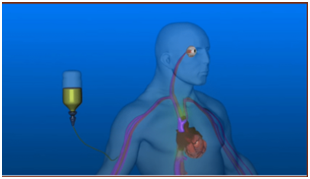
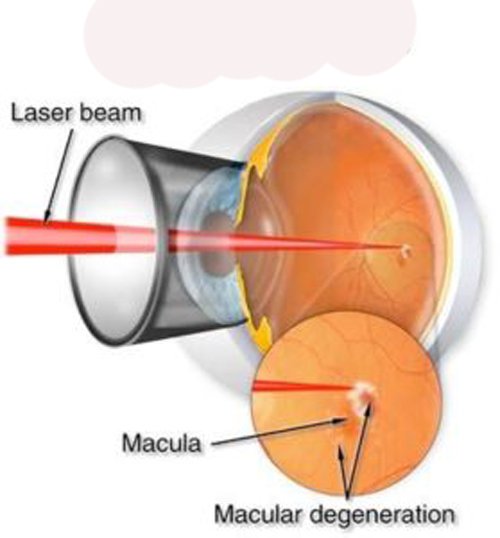
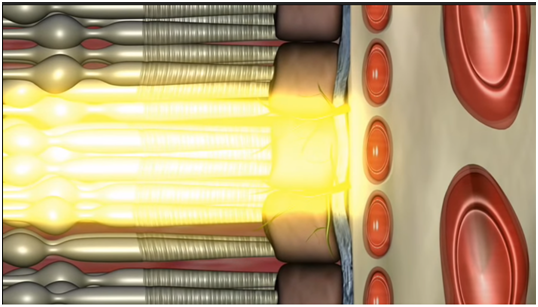

Photodynamic therapy (PDT) is a much less common treatment for wet AMD that doctors sometimes use along with anti-VEGF injections.
PDT works by using a light-sensitive medicine called verteporfin that “turns on” when hit by a specific type of laser (sometimes called a cold laser). Your doctor will shine the laser on a very small area in the back of your eye, causing the verteporfin to break down the blood vessels that are causing your vision loss.
When you get this treatment, your doctor will:
• Give a shot of verteporfin in your arm
• Put numbing medicine in your eye
• Place a special contact lens on your eye to help guide the laser
• Shine the laser onto the extra blood vessels in the back of your eye
Some people will need to get PDT more than once. Talk to your doctor to find out if you will need more treatments to help stop vision loss from AMD.
How
do I live with vision loss from AMD?
Not everyone with AMD develops late AMD or gets it in both eyes. But if you do, living with vision loss from AMD can be challenging. Having low vision means that even with glasses, contact lenses, medicine, or surgery, your vision loss makes it hard to do everyday tasks.
The good news is, there are things that can help — like low vision devices and vision rehab services. Vision rehab can help you learn the skills you need to stay independent and active with low vision.
WHAT’S THE PROPER DIET FOR MACULAR DEGENERATION PATIENTS?
Nutrition can help slow down the effects of macular degeneration or preventing it altogether. The
following nutrients play a positive role in eye health:
• Anthocyanin,
• Lutein,
• Zeaxanthin,
• Meso-zeaxanthinOmega-3,
• Vitamins A-C-E,
• Zinc, selenium, and magnesium.
ANTHOCYANIN:
Anthocyanin is a coloring agent (pigment), which is rich in red-purple vegetables and fruits. It has astrong antioxidant capacity. It can help retina problems caused by aging or exposure to solar rays.
LUTEIN, ZEAXANTHIN and MESO-ZEAXANTHIN:
Three dietary carotenoids, lutein, zeaxanthin and meso-zeaxanthin accumulate at the central retina (macula), where they are collectively referred to as macular pigment (MP).They keep the macula safe from blue light and preserve the nerve cells through their antioxidant effect. As their quantity decrease with age, nutritional supplement may become necessary for preventing Macular Degeneration. Lutein also helps reduce cataract risk development by protecting the lens from solar rays.
OMEGA 3:
Omega 3 helps regulate the development of blood vessels.Docosa Hexaenoic Acid (DHA), which is a type of Omega-3 fatty acid, supports both the structure and
functions of retina.
VITAMINS A-C-E:
These may help prevent the disease’s progression from dry form to a wet form, which has a more aggressive course.
ZINC:
Zinc helps prevent the progression of the disease from dry type to wet type.
SELENIUM:
It has a protective effect against dry-type macular degeneration.
RECOMMENDATIONS:
It is impossible to remove the age-related and hereditary factors that cause Macular Degeneration altogether. However, other risk factors can be controlled.
• Do not smoke
• Increase the consumption of leafy greens and fruits
• Do not pour down the cooking water of vegetables and consume while it is still fresh.
• Follow the Mediterranean-eating pattern.
• Stay away from foods like fried food that contain trans-fat and increase olive oil consumption.
• Salt consumption should not exceed 5 milligrams daily, and hyper-saline nutrients like tomato sauce, pickled or brined food should be avoided.
• Avoid foods like butter, tallow, tail fat that are rich in saturated fats.
ANTHOCYANIN:
LUTEIN, ZEAXANTHIN and MESO-ZEAXANTHIN:
Vitamins A-C-E:
ZINC: SELENIUM:
.png)


















1.jpg)
1.png)
1.png)
1.png)


.png)
.jpg)
Comments